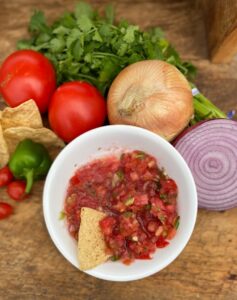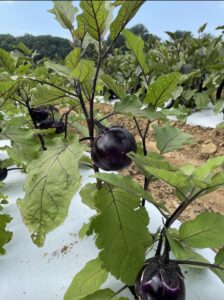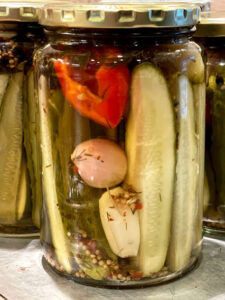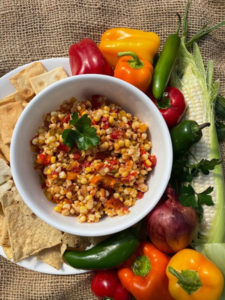Summer Bounty: A Guide to Tomatoes, Eggplant, Cucumbers, Peppers, and Sweet Corn
Summer Bounty: A Guide to Tomatoes, Eggplant, Cucumbers, Peppers, and Sweet Corn
Summer is the season of abundance, bringing a vibrant array of fruits and vegetables to our tables. Among the most cherished summer crops are tomatoes, eggplant, cucumbers, peppers, and sweet corn. Let’s dive into how these crops are planted and harvested, along with some delicious recipe ideas and tips for canning and preserving. Tomatoes Planting… Read More »

Tomatoes
Planting and Harvesting:
- Planting: Tomatoes thrive in well-drained soil with plenty of organic matter. We spend time nourishing our soil by adding plenty of composted matter to the soil to provide structure and nutrients. Our tomatoes are started indoors from seeds in our greenhouses 6-8 weeks before the last frost date and transplanted outdoors after the danger of frost has passed. They require full sun and consistent irrigation and will see our trickle hoses attached to the plants in the fields which helps save water.
- Harvesting: Tomatoes are ready to harvest when they are fully colored and slightly soft to the touch. That is when our farm production team will gently twist or cut the fruit from the vine to avoid damaging the plant. We grow both determinate and indeterminate types of tomatoes on our farm. The difference between determinate and indeterminate is that determinate tomatoes (such as plum and round varieties) grow in a bush-like shape while indeterminate tomatoes (such as cherry, grape and heirloom tomatoes) require staking. We stake all of our tomatoes to keep them clean and off the ground for better disease control.
Recipe Ideas:
- Fresh Salsa: Combine diced tomatoes, onions, jalapeños, cilantro, lime juice, and salt for a
refreshing summer salsa.
- Caprese Salad: Layer slices of fresh tomatoes with mozzarella cheese, basil leaves, and a drizzle of balsamic reduction.
Canning and Preserving:
- Tomato Sauce: Cook down tomatoes with onions, garlic, and herbs, then blend and can for a versatile sauce. Check out Miss Jenn’s recipe for roasting tomatoes for a no-waste way to use softer tomatoes.
- Sun-Dried Tomatoes: Slice tomatoes and dry them in the sun or a dehydrator, then store in olive oil for a flavorful addition to dishes.
Eggplant
Planting and Harvesting:
- Planting: Eggplants prefer warm soil and are best started indoors 8-10 weeks before the last frost date. Our team will transplant them outdoors when the soil temperature is consistently warm usually in late May or early June. They need full sun and regular watering. We grow a variety of eggplant on our farm including Sicilian, Large, Fairytale, White and others.
Harvesting: We harvest our eggplants when they are glossy and firm, usually when they reach 6-8 inches in length. Our field production team will use a knife or scissors to cut them from the plant, leaving a bit of the stem attached before bringing them fresh to our market.
Recipe Ideas:
- Baba Ganoush: Roast eggplants until soft, then blend with tahini, lemon juice, garlic, and olive oil for a smoky dip.
- Eggplant Parmesan: Bread and fry eggplant slices, then layer with marinara sauce and cheese, and bake until bubbly. Try this curated Eggplant Caprese Salad recipe on our website provided by Miss Jenn, our culinary specialist.
Canning and Preserving:
- Pickled Eggplant: Slice eggplant and pickle in a vinegar brine with spices for a tangy snack.
- Frozen Eggplant: Blanch slices of eggplant and freeze for later use in recipes like ratatouille.
Cucumbers
Planting and Harvesting:
- Planting: Cucumbers grow best in warm, well-drained soil with plenty of sunlight. They can be direct-seeded into the garden after the last frost or started indoors a few weeks earlier. They need regular watering to produce crisp, juicy fruit and require plenty of space as they are a climbing vine, part of the Cucurbitaceae family.
- Harvesting: Harvest cucumbers when they are firm and green, before they turn yellow and become overly ripe. Pick them frequently to encourage more production.
Recipe Ideas:
- Cucumber Salad: Slice cucumbers and toss with vinegar, sugar, and dill for a refreshing side dish. Find more cucumber recipes here on our website.
- Tzatziki Sauce: Combine grated cucumber with Greek yogurt, garlic, lemon juice, and dill for a versatile sauce. We used our own cucumbers in a sauce that accompanied our panko battered cauliflower offered as a special at our Farmhouse District Food Hall.
Canning and Preserving:
- Pickles: Preserve cucumbers in a vinegar brine with dill, garlic, and spices for crunchy
pickles. Check out this easy recipe for pickles on our website.
- Cucumber Relish: Chop cucumbers finely and combine with onions, peppers, and a sweet vinegar brine for a tangy relish.
Peppers
Planting and Harvesting:
- Planting: Peppers need warm soil and plenty of sunlight. Start seeds indoors 8-10 weeks before the last frost and transplant outdoors after the danger of frost has passed. They require consistent watering and benefit from mulching.
- Harvesting: Harvest peppers when they reach the desired size and color. Use scissors or a knife to cut them from the plant, leaving a small portion of the stem attached.
Recipe Ideas:
- Stuffed Peppers: Fill bell peppers with a mixture of rice, ground meat, and vegetables, then bake until tender.
- Pepper Jelly: Cook down hot peppers with sugar and vinegar to make a sweet and spicy jelly.
Canning and Preserving:
- Roasted Peppers: Roast peppers until charred, then peel and store in olive oil for a flavorful addition to dishes.
- Pepper Sauce: Blend hot peppers with vinegar and salt for a homemade hot sauce.
![Alstede Fresh Roasted Corn Salsa]() Sweet Corn
Sweet Corn
Planting and Harvesting:
- Planting: Corn needs well-drained soil and full sun. We sow seeds directly into the garden after the soil has warmed in the spring and will continue our plantings weekly until August to ensure corn through the fall. We plant in blocks as well as rows to ensure good pollination.
- Harvesting: Corn is ready to harvest when the silks turn brown and the kernels are plump and milky. Pull back the husks slightly to check before picking. Our pick your own corn is now open for the season, learn more here.
Recipe Ideas:
- Grilled Corn on the Cob: Brush corn with butter and grill until charred for a smoky, sweet treat.
- Corn Chowder: Combine fresh corn with potatoes, onions, and cream for a hearty soup. Check out this easy recipe for corn salsa here.
Canning and Preserving:
- Corn Relish: Combine corn with bell peppers, onions, and a tangy vinegar brine for a zesty relish.
- Frozen Corn: Blanch corn kernels and freeze for later use in soups, salads, and casseroles.
Summer’s bounty offers endless possibilities for fresh, delicious meals. By preserving some of this produce, you can enjoy the flavors of summer all year long.


 refreshing summer salsa.
refreshing summer salsa. Harvesting:
Harvesting:  pickles. Check out this
pickles. Check out this  Sweet Corn
Sweet Corn




